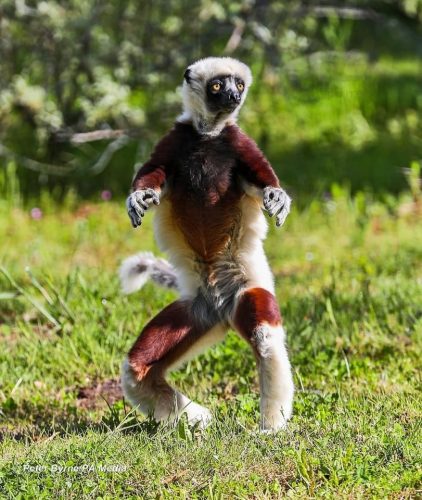Conservationists at the zoo have started the first conservation breeding programme in Europe for one of the world’s most endangered primates.
A pair of Coquerel’s sifaka lemurs, a species listed as critically endangered on the International Union for Conservation’s of Nature (IUCN) Red List, have become the first of their kind to ever set foot in Europe, after arriving from America.
Female Beatrice (8) and male Elliot (8) have been welcomed by conservationists at the zoo after travelling almost 4,000 miles from the Duke Lemur Centre, an organisation based in North Carolina which studies and protects lemurs.
Three other pairs will soon follow and move to two zoos in Germany who will, together with us, establish a vital new European endangered species breeding programme for the animals.
Endemic to Madagascar, Coquerel’s sifaka lemurs are highly threatened with its population suffering an 80% decline in just 30 years due to mass-scale loss of its forest home.
PSSSTT
“This is the very first time that this wonderfully charismatic species of lemur has ever been in Europe and it’s taken three years of work with the Duke Lemur Centre to prepare for caring for them. Coquerel’s sifaka lemurs are critically endangered and what we aim to do now is to establish a safety-net population in Europe’s top zoos and help to prevent their extinction and preserve options for future conservation.”
Mike Jordan, Animal & Plant Director
“Deforestation is a huge issue in the lemurs’ native Madagascar and they are restricted to several tiny fragments of forest in North Western Madagascar. Sadly, a lot of the protection that was once in place for forests and national parks no longer exists, which is why forests are being destroyed en masse – from burning to provide pasture for livestock to logging for charcoal production. In the wake of such dramatic habitat loss, it’s vital that progressive, conservation zoos use their unique position and knowhow to protect this iconic species from being lost forever.
“Coquerel’s sifaka lemurs are very delicate animals and a specific set of skills and expertise is needed to look after them. Our keepers are some of just a few people in the world that now have experience of caring for them – that’s a big reason for why Chester Zoo was chosen to for this important new European project.”
After three years of planning for their arrival, keepers at the zoo say that Beatrice and Elliott have already started exploring and getting to grips with their new home – including showing off their unique ability to ‘dance.’
Holly Webb, Primate Keeper at the zoo, travelled to America to spend time caring for the lemurs prior to their journey to the UK…
PSSSTT
“When down on the ground, Coquerel’s sifaka lemurs move around with a fascinating sideways gallop while gracefully holding up their arms for balance – it rather looks like they’re doing an elegant dance. When in the trees they jump from spindly branch to branch with incredible precision. They’re amazing acrobats and can leap an impressive 30 feet with their powerful legs – that’s quite a distance when you’re only two feet tall.”
Holly Webb, Primate Keeper
“Sifaka have special nutritional needs and our team of keepers is now working closely with our onsite veterinary and logistics teams to help determine a specific diet plan for them. As vegetarians, they’ll eat a mixture of different plant species, so we’ve began growing some more unusual and tasty trees just for them, right here at the zoo.
“It’s a real, real privilege to be able to care for this enthralling species and we’re sure that visitors to the zoo will love learning all about them. Crucially though, we hope that Beatrice and Elliot will help us to highlight the struggles that these charming, charismatic animals face in the wild and will inspire people to want to do their bit to help protect the future of nature on our planet.”
Coquerel’s sifaka lemurs tend to have offspring early on in the year and experts at the zoo are hopeful that their new arrivals will go on to breed in 2022 and provide a crucial boost to the insurance population for the species.

Meanwhile, conservationists from the zoo have been engaged in protecting habitats and the unique species they are home to in Madagascar for more than 10 years. In 2015, the Malagasy government established The Mangabe New Protected Area, co-managed by the zoo’s field partner Madagasikara Voakajy and the communities that live in the Mangabe region, providing a safe haven for nine species of lemur, as well as lots of other threatened species living on the island.
NOW is the time to ACT FOR WILDLIFE. Conservation is CRITICAL; species are under threat. TOGETHER we can make a BIG difference. Take action TODAY and join us in PREVENTING EXTINCTION.
OUR TEAM OF EXPERTS WORK IN SIX REGIONS AROUND THE GLOBE – REPRESENTING SOME OF THE PLANET’S MOST BIODIVERSE HABITATS. Discover more about our SCIENCE AND CONSERVATION work.